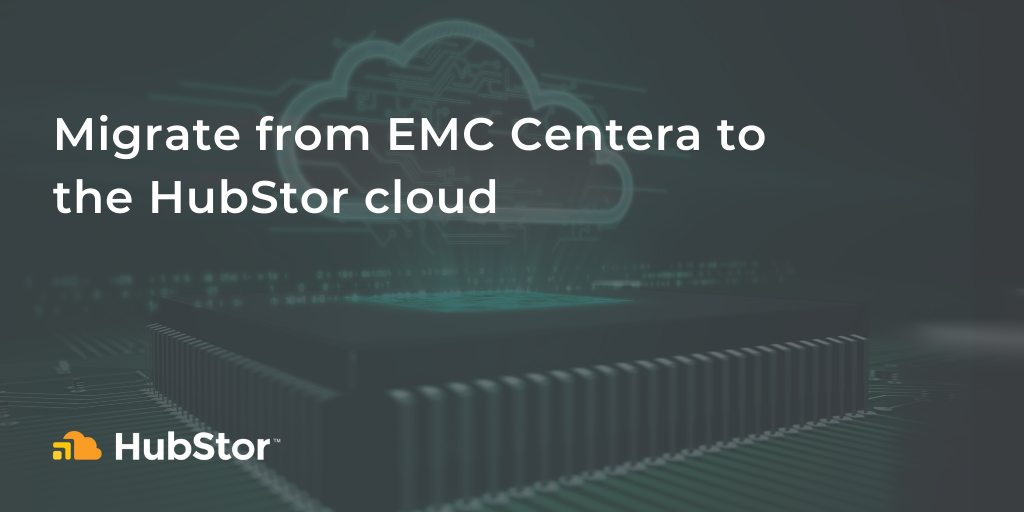If you’re reading this article, you, like many other EMC Centera customers, are looking for a way out. With Centera having reached end-of-life, you’re not alone. And, like many others, you’re probably finding that your options for moving off Centera are both complex and expensive, boiling down to one of three options:
- Engage a specialized third-party vendor to migrate your data from Centera to an an alternative like Dell EC2 or something from NetApp. In addition to the massive capital expenditure required to procure the compliance storage capacity from the storage vendor, the migration vendor will happily take their pound of flesh.
- Develop your own in-house migration software to move the data to another expensive on-premise device, or to the cloud. Unfortunately, this is not a trivial task, and far outside the capabilities of most organizations.
- Engage a specialized third-party vendor to migrate your data from Centera to a private cloud vendor. While the migration vendor will still take their pound of flesh, you can usually switch to a monthly PAYGO model with the cloud vendor. Of course, there are other complications such as maintaining metadata, WORM compliance, and the ability to query the data for discovery searches, which is usually not well supported. Many cloud vendors also make it expensive to egress data, providing a kind of soft lock-in which makes it prohibitive for you to ever leave their platform, should you wish. And as for chain-of-custody, that’s a great question to ask if you want to see most vendors squirm.
But there's another option available: HubStor.
With HubStor you can migrate your EMC Centera data, from any application, to the cloud, and:
- Maintain item-based WORM compliance, inheriting the exact retention specified in Centera for each object.
- Maintain an intact chain-of-custody, migrating clips directly from the Centera device into HubStor.
- Maintain core metadata fields like last accessed.
- Migrate items from Centera regardless of the application which wrote them.
- Support full-text search of items in the cloud.
- Leverage the advanced analytics, lifecycle management, tiering, auditing, and industry leading security of the HubStor cloud platform.
Oh, and the migration is FREE!
That’s right: At HubStor our experience working with Centera devices goes back 15 years, and we’ve developed a powerful migration application that is able to move data directly from Centera to our cloud, and we give that to you, along with knowledgeable hands-on assistance during the migration, for free.
Of course, I’m sure this all sounds too good to be true, and so the question most of you have is: What will it cost to store my data in HubStor?
The answer is much less than you would think. In general, the more data you store in HubStor, the cheaper it is. HubStor also allows you to leverage the uber low-cost storage of the archive tier, which allows pricing as low as $0.00081/GB/month. But let’s say that you’re a customer with 50 TB of data which you need to keep immediately accessible (i.e. not on the archive tier), and have it searchable. Rough pricing is going to land you around $0.011/GB/month.
The savvy amongst you will then ask the next question, which you should always ask when engaging a cloud vendor:
How expensive is it to get my data out if needed?
For this HubStor has taken a unique position in the market: We provide at-cost egress of data, and include the software needed to move all your data out of HubStor, should you ever wish. Because HubStor is built on the Microsoft Azure cloud, you would still have to pay the Azure costs for any egress, but HubStor would not markup that amount at all. And, if you migrate data to either Azure Blob Storage or a VM in Azure, you can avoid even paying the Microsoft egress costs, and essentially get your data out of HubStor for free.
To summarize the cost model of HubStor, as it relates to EMC Centera, you get:
- Free migration software, including knowledgeable technical support through the migration process.
- PAYGO, cancel anytime, no lock-in WORM compliant cloud storage.
- The ability to leverage the archive tier for storage pricing that starts as $0.00081/GB/month.
The ability to egress all your data for free, should you wish to cancel.
The Centera migration process
So, what exactly does this migration process look like? It basically boils down to three steps:
- Use the HubStor Centera Migrator Utility to discover and profile the raw clips, tags, metadata, and blobs on the Centera device. This information is used to identify the exact parameters and structure to use for the migration.
- Use the HubStor Centera Migrator Utility to traverse all clips on the Centera device, and stage the clip IDs hierarchically for ingestion to HubStor.
- Use the HubStor Connector Service to directly pull the identified clips from the EMC Centera device, and store them in the HubStor cloud platform.
Step 1: Sizing up your Centera data
The first step is to get a handle on exactly what is on your Centera device(s). The complication is that different applications write data to Centera differently, and you need to understand the structure to ensure the migration is meaningful. The HubStor Centera Migrator Utility makes this process simple, as it includes a “Raw Extraction” mode, which can be used to traverse all clips, or a range of clips, outputting all information about each clip to a JSON file.

Figure 1. HubStor Centera Migrator Utility - Session configuration.
Once you configure the output path, you simply run the task, allowing it to extract the data to JSON.

Figure 2. HubStor Centera Migrator Utility - Raw extraction processing.
The result of running this extraction mode against your Centera is a JSON file per clip, which allows the full details of clips to be understood. This process of dissecting the clip JSON files, and using this information to configure the migration is a bit of an art, one which we will explore in more detail in a follow-on blog post.
Step 2: Staging the Clip IDs
Once the data from the HubStor Centera Migrator Utility’s raw extraction has been analyzed, the next step is to use that data to configure a “Migration Preparation” session. Advanced capabilities are provided both for extracting hierarchy from the clip data, as well as extracting the name from the clip data:

Figure 3. HubStor Centera Migrator Utility - Configuring the migration preparation crawl.
Once the migration preparation crawl is configured, you simply run it. The result will be a series of clips.txt, output to some staging volume, and arranged in a folder hierarchically based on your configured rules. Inside each clips.txt are the clip IDs that should be considered as being a member of the given folder. Once again, my follow-on post will give more detail on configuring the migration preparation crawl.
Step 3: Migrate from EMC Centera to HubStor
The final step in the migration process is to use the output of the HubStor Centera Migrator Utility’s migration preparation crawl (i.e. the hierarchically arranged clips.txt) to actually migrate the data into HubStor. The HubStor Connector Service is configured with the Centera cluster connection, and the location of the migration preparation output:

Figure 4. HubStor Connector Service. Configuring the Centera connector.
With the HubStor Connector Service configured, you simply run the crawl. The Connector Service will traverse the clips.txt files, mirroring the folder structure to the HubStor cloud, and migrating the clips, with retention, directly into HubStor. This migration is performed as a single hop, and a database of migrated clips is maintained, which can provide chain-of-custody if needed. All data is encrypted in transit, and automatically compressed as it is sent, to ensure efficient usage of your network bandwidth.
The HubStor value proposition
Once your EMC Centera data is migrated to HubStor, what exactly do you get from the HubStor platform?
Well, for one you get industry-leading WORM compliant storage, delivered for fractions of a penny per GB per month.
You also get a highly secure born-in-the-cloud data management platform, including analytics, dynamic tiering and tagging, DLP, powerful discovery and legal hold capabilities, that is SOC 2 Type 2 certified, and delivered as a fully-managed solution. HubStor deploys as a single tenant model, which means it is secure by default, and you get your own dedicated sandbox in the cloud.
And, importantly, you get your data into a cloud platform that makes it easy to get your data out, should you ever need to.



